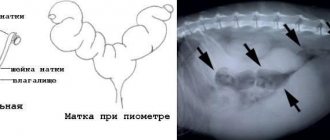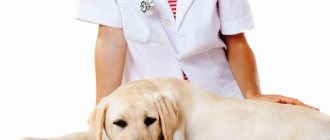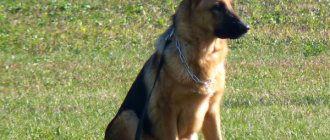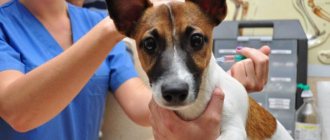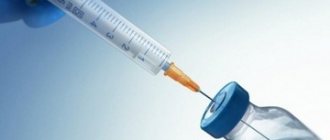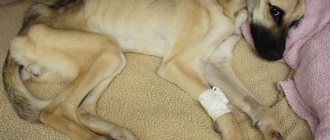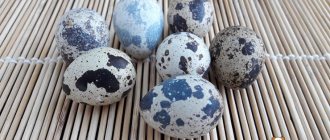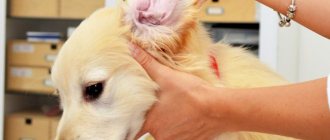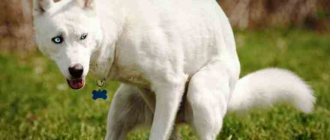Characteristic nuances
Coming out of anesthesia
It is better to leave the bitch in the clinic so that veterinary staff can monitor her when she comes out of anesthesia. After 8–10 hours, the dog needs to be given water. If she cannot lap on her own, you can squirt some water from a syringe into her mouth.
Seam care
It is necessary to protect the seam from gnawing. To do this, a post-operative blanket is put on the pet, and in some cases, an additional Elizabethan collar.
Dog after surgery
The wound surface is examined twice a day. Treated with an antiseptic. The most convenient is Chlorhexidine, preferably water-based. If your doctor recommends using an antimicrobial ointment, Levomekol is best. When the discharge from the sutures stops, limit yourself to a visual inspection. If healing is slow or bloody or purulent discharge is detected, seek veterinary help.
Chlorhexidine
Nutrition
Feeding is resumed 24 hours after recovery from anesthesia if the pet is feeling well. The first portions of food should be liquid. Feed chicken broth or specialized premium ready-made food. It is advisable to keep your dog on wet food for at least a month. Adherents of natural nutrition should consult with professional dog handlers.
Special food for dogs
Recovery
For the first 5 days, oilcloth is placed under the bitch, regularly changing the mat if it gets wet. If the suture heals successfully, the animal is taken out for a short walk. The bitch should not be let off the leash and allowed to jump. Movements should not be completely restricted, otherwise adhesions will occur. The sutures are removed by a veterinarian within 10–12 days.
Dog after sterilization on the first day
After sterilization, the dog recovers from the state of anesthesia for the first few hours. The animal comes to its senses gradually over the first 24 hours.
The dog needs proper care after sterilization, so it must be carefully looked after.
If there are disturbances in the breathing process (the animal is breathing heavily), problems with the pulse, changes in the shade of visible mucous membranes (cyanotic or anemia), changes in body temperature, this is a reason to immediately contact a veterinarian. Complications of this kind rarely occur if the operation was performed correctly.
In the first days, and especially the first 24 hours after surgery, the animal comes out of anesthesia, and the body actively removes narcotic substances, so it is not recommended to place the pet on high surfaces due to the risk of falling. The dog's bed should be located on the floor, away from drafts and heat sources. If the animal is cold, you can cover it with a warm blanket.
Immediately after your pet wakes up, you can give her some water. If the animal refuses, it is necessary to moisten the mouth and tongue with water. It is not recommended to give your dog food or other food for several hours after recovery from anesthesia. Small portions of food can be offered to the animal the next day.
On the first day after sterilization, the animal must receive painkilling injections prescribed by a veterinarian. This will allow your pet to survive the first 24 hours after abdominal surgery as comfortably as possible. It is also necessary to wear a special blanket to prevent the animal from licking the seams. There should be several blankets in order to promptly change them as they become dirty.
Feeding the dog after sterilization
During the first time after the operation, the dog may experience constipation or, in other words, constipation. After the administration of special drugs during anesthesia and recovery from a state of deep sleep, constipation is part of the norm. Constipation can be painful for your dog, so the food should be high in calories but as easy to digest as possible.
It is recommended to give food in ground form and semi-liquid. If the dog does not want to eat, there is no need to force food into it. Long-term refusal to eat – more than 3 days – is a direct reason to consult a veterinarian.
It’s good if, after recovering from anesthesia, the dog shows a desire to drink plain water. But even if the animal does not want to drink for some time, there is no reason to worry. You can offer to drink water from a spoon or try to drink from a syringe without a needle. It is important at this moment to ensure that the animal does not choke.
Dog food after sterilization should be carefully selected by a veterinarian. He will be able to recommend super-premium medicinal food that will satisfy all the nutritional needs of the animal’s body without causing obesity. You should not save on feed, because the health of the animal directly depends on the quality of the feed.
Recovery after pyometra and its prevention
Recovery after surgery involves caring for the dog, in particular suture treatment, administration of antibiotics and supportive medications. Usually the animal eats with appetite within a few days, and its condition improves significantly. As a rule, painkillers are prescribed in exceptional situations and in the first days after surgery. In the future, the dog needs to take care of itself until the suture is completely healed and strength is restored, so such drugs have the opposite effect. The pet moves actively without feeling pain and can get complications.
Prevention of pyometra is to sterilize the bitch before her 3rd heat, or better yet, before her 1st. Only complete removal of the uterus and appendages eliminates purulent inflammation.
If a dog is bred, it is done after 2-3 heats so that it recovers before the next pregnancy. It is also necessary to monitor the condition of the genital organs and timely treatment of their diseases. In case of false whelping, after estrus, the amount of meat and dairy products is reduced for 2 months, and physical activity is increased. It doesn’t hurt to have genital hygiene, especially during estrus. The secretions are carefully washed off, and the hair around the loop is shortened. Modern equipment in veterinary clinics and products from pharmacies make it possible to monitor hormonal levels and conduct periodic examinations of pets. After all, the earlier pyometra is detected, the easier it is to treat it and restore the dog.
If you find an error, please select a piece of text and press Ctrl+Enter.
Surgery to remove the uterus associated with pathology for a large dog (weighing 30 kg or more)
To prevent pyometra, it is best to sterilize as early as possible - preferably before the first heat.
If the female is intended for breeding or you want to get offspring from her for yourself, you should not use hormonal drugs to suppress estrus, only herbal sedatives (Kot Bayun, Stop - stress). Estrus in females repeats regularly and their behavior during this period can be very unpleasant and burdensome for the owner. Sterilization in this case is the best solution for the animal and its owner, because it is relatively easy to tolerate and does not have long-term consequences for the animal, unlike the use of drugs to suppress estrus. HEMOMETER.
A disease associated with the accumulation of blood in the uterus. Bloody discharge is the most difficult to detect and identify as a symptom of some kind of pet disease. Externally, it is the release of drops of blood from the pet’s genitals. Bleeding can be caused by both local causes and general diseases accompanied by blood clotting disorders. Local causes of bleeding are diverse: ruptures of the perineum, external genitalia and uterus, damage to the tumor of the vestibule of the vagina and vagina (transmissible venereal tumor, leiomyomaidr.), atony and hypotension of the uterus.
Ruptures of the perineum, external genitalia and vagina are most often observed as a result of untimely and (or) incorrectly provided obstetric care (rapid labor, inept protection of the perineum, the use of obstetric forceps for a large fetus, narrow pelvis, etc.). Severe bleeding is usually noted when the clitoris is damaged. They begin during childbirth and are rarely protracted; they are easily recognized by inspection and palpation of the external genitalia, perineum and vagina.
Hypotony and atony of the uterus
- The most common cause of postpartum hemorrhage. Physical inactivity, prolonged labor, excessive multiple births, polyhydramnios, and retained placenta predispose to the development of pathology. Bleeding occurs in the afterbirth stage due to subinvolution of the placental segments of the uterus. Contractile activity of the uterus is reduced. Blood accumulates in the cavity of one or both uterine horns (hemometra). External bleeding is usually noted when the animal is lying down. There are no signs of coagulopathy.
Coagulopathic postpartum hemorrhage
are rare in dogs and can be caused by a wide range of factors (calcium deficiency, thrombocytopenia, poisoning with hemolytic poisons, etc.). They pose a particular danger to the life of the female, so timely and qualified assistance is necessary. The source of bleeding is usually the uterus. Laboratory methods of blood testing play an important role in recognizing this form of postpartum hemorrhage.
In case of uterine bleeding caused by incomplete rupture of the uterus, subinvolution of its placental segments, drugs that contract the uterus, hemostatic agents, antibiotics, etc. are first prescribed. If conservative therapy is ineffective, hysterectomy is resorted to. Emergency hysterectomy is indicated for complete uterine rupture and massive uterine bleeding of unknown origin.
For coagulopathic bleeding
treatment should be comprehensive and directed against the underlying disease that caused the bleeding disorder.
ATTENTION!!!
The health of a pet largely depends on the attitude and care of the owner. Any serious illness can be prevented, cured, or at least alleviated. Pets, unfortunately, cannot tell what is wrong with them. The golden rule: for any unclear changes in the animal’s condition, you need to contact a veterinarian.
The diagnosis is made based on the results of ultrasound diagnostics, blood tests and gynecological examination of the female.
Treatment consists of ovariohysterectomy.
How to care for a dog after hysterectomy surgery?
How to care for a dog after hysterectomy surgery?
Surgery to remove the uterus from a dog is a complex process that requires special attention and care for the pet. In some cases, surgical intervention cannot be avoided. Pay attention to the following symptoms in your animal:
- reluctance to eat;
- low physical activity;
- digestive system disorder;
- constant changes in body temperature;
- the dog feels discomfort when touched or pressed on the stomach.
If such signs occur, then it is possible for a surgeon to remove the dog’s uterus.
.
If the doctor has prescribed surgery, you need to know how to care for your pet after the surgery. uterine
may occur and, as a result, complications leading to unpredictable consequences.
In general, postoperative care consists of ensuring that the dog wears a protective blanket until the suture is completely healed and does not lick the injury site. Blankets need to be changed periodically. It is also necessary to treat the seam daily.
The first day after surgery
During surgery, the animal is very cold. During the day after the operation, the cold does not leave the pet; she spends almost all her time sleeping. Cover the dog with a blanket, making sure that it is not in a draft.
It is best to place the dog on a mattress or bed with a flat surface. It is strictly forbidden to place your pet near a radiator or use a heating pad to eliminate the cold.
While the dog is sleeping, involuntary urination may occur, so place special diapers on it.
Once every 30 minutes, carefully and slowly shift the animal from one side to the other. This will significantly reduce the risk of pulmonary edema or numbness of the extremities.
It is important that you constantly monitor your pet during the day after surgery. She should breathe evenly. It's good if she reacts to stimuli. If you see that your animal is acting restless, you should contact your veterinarian.
It is also advisable to follow these recommendations:
- if the doctor has prescribed drops for the dog to moisturize the mucous membranes, they should be used every half hour;
- If your dog's heart beats irregularly, you should consult a doctor;
- If a day after the operation the pet has not regained consciousness or reacts poorly to stimuli, it is important to contact a veterinarian.
Remember, if, upon regaining consciousness, the animal behaves aggressively, panics, is afraid or does not recognize its owners - this is a normal state. Calm your pet, pet her and say a few pleasant words until the post-operative condition passes.
Tips for processing seams
Often the animal feels severe pain in the suture area, so in most cases painkillers are prescribed. It is necessary to give them to the dog strictly according to the instructions. It is also important to follow the following rules:
- once a day the blanket needs to be changed to a clean one;
- When processing a seam, do not completely remove the blanket. Just untie it and move it slightly to the side;
- The dog should not take off the blanket. If she keeps trying to do this, use an Elizabethan collar;
- You cannot bathe a dog while it is in a blanket;
- make sure that the dog's physical activity is kept to a minimum;
- It is forbidden to remove stitches yourself. Some sutures dissolve on their own, and some can be removed by a veterinarian;
- treat the seam every few hours with a product prescribed by your veterinarian.
The dog can drink water after surgery as soon as it can hold its head upright. It is worth noting that the animal is often prescribed a special diet, which must be followed until complete recovery. This is necessary to avoid tearing the seams.
Thus, postoperative care for a dog includes constant monitoring of the animal’s condition.
It is enough to notice the slightest changes in the dog’s behavior and well-being so as not to provoke complications. The veterinarian will give you detailed recommendations that must be followed strictly.
Source: https://www.belanta.vet/vopros-otvet/view/Ginekologiya/uhazhivat-sobakoj-posle-udaleniya-matki/
